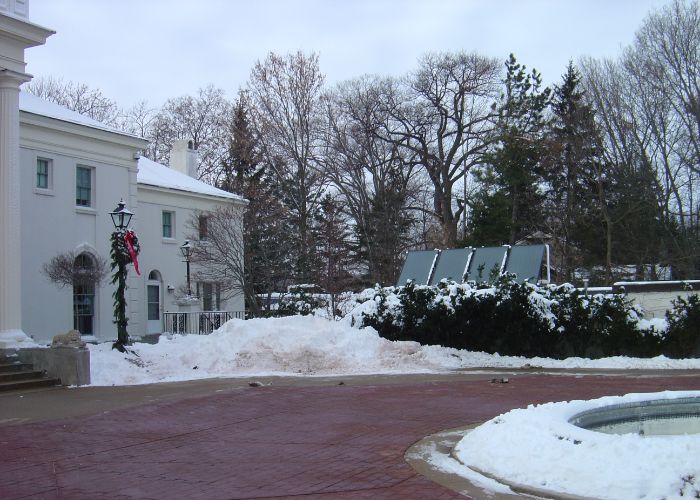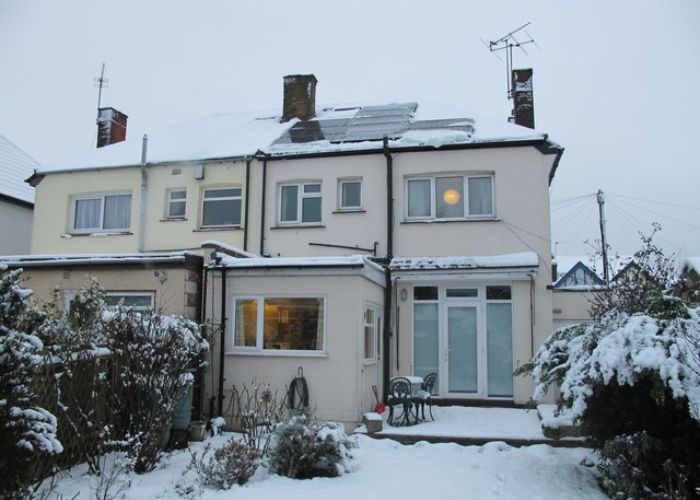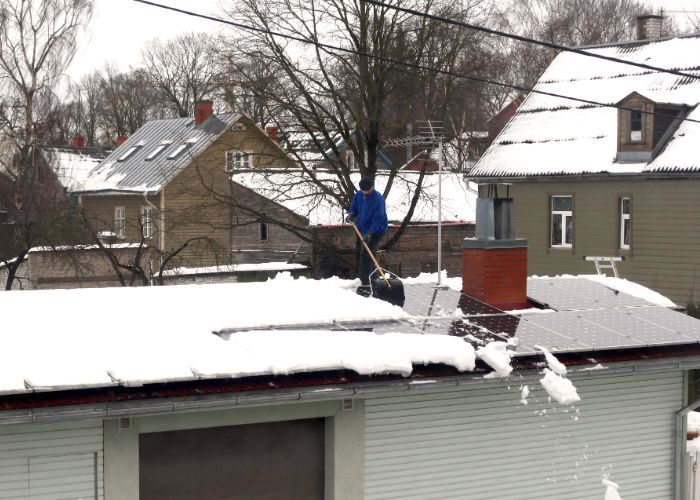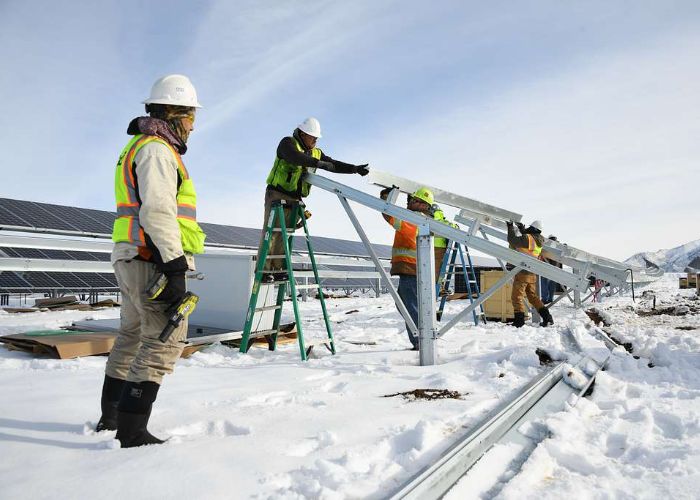Headquarters: 535 Pine Street, Central Falls, RI 02863
Call us: 401-274-0111

For those living in snowy climates, solar panels can be a great way to harness the power of the sun. However, snow buildup on solar panels can significantly reduce their efficiency at generating electricity. Luckily, there are several effective methods for preventing and removing snow from solar panels.
So, how to keep snow off solar panels? In brief, you can brush light snow off panels frequently to prevent dense buildup. Use scrapers or squeegees to gently clear compacted snow. Consider tilted or adjustable mounts to allow snow to slide off smoothly. Install heating systems to automatically melt snow for high maintenance-free operation.
In this handy guide, we'll explore the best practices for keeping your solar panels clear throughout the winter season. So grab your snow shovel, crank up the holiday tunes, and let's shed some "light" on maximizing solar panel performance amidst Old Man Winter's icy grip!
Optimizing the angle or tilt of your solar panels can make a big difference when it comes to shedding snow. Solar panels are typically mounted at an angle facing south to maximize sun exposure. However, in cold climates, consider tilting panels at a steeper 45-60 degree angle to encourage snow to naturally slide off the surface. The slick backing of solar panels makes snow easily glide off at sharper inclines.
Just take care when tilting panels not to cast shadows on other panels and decrease overall efficiency. Finding the sweet spot angle for maximum sunlight and minimum snow pileup may take some trial and error. But with climate change bringing less predictable winter weather, having the ability to adjust panel angles can be a useful adaptation.
Special solar panel coatings can also help repel snow buildup. Hydrophobic spray-on treatments use nano-chemicals to create a water-resistant barrier that prevents snow and ice adhesion. A little spritz goes a long way to giving panels the slick and slippery properties needed to keep snow from sticking. Anti-stick snow sprays offer a similar effect. Some even contain glycol compounds to melt snow on contact!
When applying these hydrophobic or anti-stick coatings, be sure to cover the entire surface of each panel. Focus on spraying panel edges and frames where snow accumulation often starts. Reapply coatings 2-3 times per winter season for best effectiveness. It's also a good idea to use rubber gloves and goggles when spraying panels overhead. Chemical runoff could irritate eyes and skin.
Just be sure to use coatings specifically designed for solar panels, as some chemicals can damage the surface. Reading product instructions carefully and spot testing on a small area first is recommended. A little preventative treatment before winter arrives can save hours of brushing and scraping later on. Keeping solar panels slick and snow-resistant with specialty sprays gives you more time to cozy up with some hot cocoa while the panels work freeze-free!

When an overnight dusting or daytime snow shower hits, don't let snow pile up. Light powdery snow can be quickly swept off using a soft brush or roof rake with an extendable handle. Think of it like brushing fresh powder off your car without the freezing, wet mess. Gently brush back and forth across panels to clear off snow before it densifies. This prevents heavy, compacted snow from adhering and freezing into ice. Set reminders to routinely clear after snowfalls so it doesn't accumulate. Removing a few inches at a time prevents damage and starts the snow melt process.
Following a huge dump or series of snow squalls, solar panels may get completely buried. Once snow densifies and adheres to the glass, simply brushing may not do the trick. When dealing with heavy-packed snow or ice, start by using a plastic snow scraper or squeegee to gently break up and clear off the worst buildup. Rubber-edged scrapers are ideal, as they won't scratch the glass.
You can also carefully use a broom or mop handle to poke and prod at snow chunks. But avoid using aggressive force, as too much pressure could crack solar cells. Let gravity lend a hand by tilting panels to dump off cleared snow. For ice, a deicing spray or gently applied heat from a hair dryer can help melt adhesion. With a little elbow grease, you'll have your panels glistening!

For frequent heavy snow, panel heating systems provide automated snow melting. Heated solar panel kits use embedded heating elements, much like the cables that heat driveway and sidewalk surfaces. Low-voltage electricity activates the heaters, which run along the backside frame and piping of solar panels. This melts away snow accumulation, allowing it to harmlessly drip off.
Heaters can be thermostatically controlled using sensors to activate only when needed. Kits are also available that harness excess solar electricity to run the heating system. This means solar panels can power their own snow-clearing process! Heating solar panels does divert some energy, but the boost in winter production outweighs the costs.
Not comfortable scrambling on icy rooftops or using power tools to detach frozen snow on tall panels? Know your limits, and don't risk injury! Many solar companies offer maintenance packages that cover periodic winter servicing. Trained technicians have the proper ropes, safety gear, and high-power tools to safely reach and clear all panels.
They can also spot-check for any winter weather damage that may need repairs come spring. Though adding maintenance service costs to your solar budget, the convenience and peace of mind may be worth the price. An expert cleaning leaves panels spotless and primed to offset those higher heating bills racked up from all of Jack Frost's frigid visits!

Snow can significantly hamper the efficiency and energy output of solar panels. As snow accumulates on the panels, it blocks sunlight from reaching the photovoltaic cells. This reduces the amount of solar radiation that gets converted into usable electricity. Even a light dusting of snow can decrease energy production by 30% or more. As snow depth increases, so does energy loss. At around 2-3 inches of snow, solar panel output can drop by up to 70-80%. Anything over 3 inches can essentially cut power generation to zero.
The snow's density also affects efficiency loss. Light, fluffy snow is less impactful than heavier, wetter snow that compact and adheres to the panels. Large snow drifts are especially problematic, completely burying panels under piles of snow. Until the snow is cleared, frozen-over panels are rendered entirely nonfunctional. This can mean days or weeks of greatly reduced solar energy capture during peak winter weather. For homeowners relying on solar power as their primary energy source, this can cause major problems and unexpected utility costs. Even grid-tied systems that supplement the main power supply can see electricity bills spike due to snow-disabled solar panels.
The financial hit from snow-related solar shortfalls is significant. One analysis estimated over $1 billion in revenue loss annually for the U.S. solar industry because of snow. For northern states that average 60-70 days of snowfall per year, the impact on solar capabilities and energy savings can be substantial. Keeping solar panels clear of snow buildup is therefore critical for ensuring they live up to their full generating potential year-round, especially during the cloudy winter months when solar resources are already limited.
With solar energy being an increasingly vital source of renewable power, keeping panels in tip-top shape through the cold months is a must. A little strategic tilting, preventative coatings, and periodic clearing go a long way in maximizing solar panel snow mitigation. And new advances like automated heaters make 24/7 winter exposure no match for harnessing those precious rays, even during the darkest days. Stay ahead of Old Man Winter by implementing these targeted snow removal techniques. Before long, you'll be reaping the benefits of solar energy year-round!
About United Better Homes
United Better Homes is an experienced company that employs GAF-certified roofers, master window installers, and solar specialists. We take our customer's homes and transform them into energy-efficient abodes that look incredible. To learn more or to schedule a FREE consultation, please don't hesitate to call us at 401-274-0111.
What do you do with solar panels when it snows?
When snow is forecast, it's important to take proactive steps to minimize buildup on solar panels. Gently sweeping off light snow before it freezes and using tools to safely clear heavy snow ensures solar panels can continue generating energy through winter storms.
Should I shovel snow off my solar panels?
Yes, it is recommended to shovel snow off solar panels to maintain their efficiency. Removing snow buildup helps allow sunlight to reach the panels, preventing significant energy production losses that can occur when snow covers the photovoltaic cells.
Can I put heat tape on solar panels?
Special solar panel heating systems and heat tape can be installed to automatically melt snow on panels. However, these heating methods divert some solar energy to run. Hence, the trade-off in energy efficiency needs to be evaluated based on local climate and average snowfall.
Do solar panels still work with snow on them?
Solar panels can still generate some electricity if they have light snow accumulation, but energy output will be reduced. Heavy snow or complete coverage of the panels will block sunlight and essentially halt energy production until the snow can be removed.